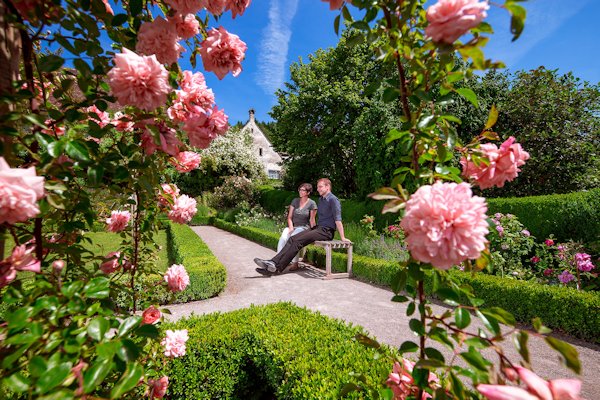Lake Constance Gardens tell a story (Engl.)
#lakeconstance
The mild climate of Lake Constance has always played right into the hands of gardeners. Over the centuries, promising parks and lovingly cultivated gardens have sprung up between the blue lake and the green banks which dominate the landscape. Since last year the network, “Lake Constance Gardens – a journey through time” has been inviting visitors to discover the most beautiful gardens around Lake Constance whilst also giving them the opportunity to learn about the exciting horticultural past of the region. The number of properties included in the green network continues to grow; from 2015 the magnificent villas and parks in Lindau, the horticultural trail in Überlingen, the Swiss medicinal garden established by Alfred Vogel as well as the park belonging to Wartegg Castle in Rorschacherberg will be included in the group.
Together, the gardens surrounding Lake Constance capture the entire development of European horticulture. Visitors experience first-hand, examples of gardens dating from the Stone Age to ancient times, gardens from the Middle Ages and the nineteenth century right through to gardens established in the modern day. And all of these styles within such easy reach of each other! If they so wish visitors can simply hop on a boat, bus or train to travel easily from garden to garden.
Reichenau is the Birthplace of Western Horticulture
Nearly 1,200 years ago the Monk Walahfrid Strabo from Reichenau published the small booklet, “Hortulus – About the Care of Gardens”. This was the first ever European publication dedicated to giving advice on gardening. On the strength of these 24 verses, which concern just as many varieties of plant, the island of Reichenau – a World Heritage Site – earned its title as the birthplace of Western hor-ticulture. Reichenau is still recognised as such today. The vegetable-covered island with its greenhouses and vineyards and its three churches, which have been awarded World Heritage status, is a dream destination for anyone blessed with those famous “green fingers”. An herb garden which was established according to the verses in “Hortulus” reminds us of the long tradition of gardening on the island of Reichenau. The island is easily reached by travelling over the raised dam by bike, on foot or by bus. Visitors might otherwise enjoy travelling to the island by boat, departing from Radolfzell, Constance or Mannenbach.
Travel through Time from Park to Park
The island of Mainau is probably the best known flower island in the World. It was here, on the 45 hectares of historical, planted woodland which dates back to the nineteenth century, that the Bernadotte family created a true paradise of flowers. The future French emperor, Napoleon III, engaged a leading landscape architect to design the English garden for Arenenberg Castle in the Swiss region of Untersee. In 1840 the legendary Earl Pückler planted a green idyll, full of surprises, around the castle in Lake Constance. Just across the way are the historical grounds of the former Charterhouse in Ittingen; as well as a Baroque garden there are two hop gardens, wine gardens, a herb garden, a prior’s garden and monks‘ garden to be seen. The rose garden, with 1,000 individual rose bushes, not only smells wonderful, but boasts the largest selection of historical rose varieties in Switzerland.
Magnificent Castle Grounds on the German Side of the Lake
On the other side of the lake, only a short boat trip away, is an unforgettable garden with a dream view. As well as providing an example of Baroque landscape archi-tecture, the park surrounding the new Meersburg Castle offers a wonderful view across the lake. From here it’s only a stone’s throw to the former monastery and castle in Salem. As soon as you enter the garden you notice the magnificent, Ba-roque formal garden. The symmetrical paths, imaginatively trimmed hedges and bushes, fountains and water basins as well as the two mazes all add to the garden’s design.
Millet for Hungry Lake Dwellers
The remaining Stone Age lake dwellings found around Lake Constance have been included on the list of UNESCO World Heritage Sites since 2011. As the archaeobo-tanical gardens in Hemmenhofen and Frauenfeld illustrate, people were already gardening in the Stone Age. Accordingly, visitors to Lake Constance gain an insight into nothing less than the history of plant cultivation in central Europe. Foxtail millet for example, which we use as parakeet food these days, buckwheat, lentils and broad beans, the first seeds used by man, are still planted and cultivated here today. Within the small area of Lake Constance you can experience the entire horticultural past of Europe; from Stone Age gardens to those from the Middle Ages right through to modern day examples. 7,500 years of horticulture make a short trip on Lake Constance an unforgettable experience. And the notion behind the “Lake Constance Gardens” continues to grow and blossom.

Baroque style garden, Salem Castle. Photo © Bodenseegärten
Four New Additions for 2015
In 2015 we will welcome four new members to the network. The English gardens of Wartegg Castle offer an idyll of ancient trees, streams and secluded clearings. In the heart of the National garden monument, dating from 1860, organic gardeners continue to cultivate almost forgotten varieties of vegetables, herbs and flowers. At the EchinaPoint in Roggwil everything is centred around the theories of the pioneer in natural medicines, Alfred Vogel, and his favourite plant, the red coneflower. Visitors can enjoy the splendour of the crimson blossoms and learn how herbal remedies are produced and how they work. The horticultural trail in Überlingen connects the most beautiful green attractions of the town, including the town garden with its exotic plants and mighty, giant trees. 30 magnificent villas and parks are to be found along the horticultural trail in Lindau – all of them true jewels in the crown of the Bavarian banks of Lake Constance.
Individual Discoveries
Tour recommendations for individual journeys through gardening-time, whether by boat, bike, bus or train, are available for guests. There is also an all-inclusive trip offered by the tour operator “Radweg-Reisen” which may be booked on an individual basis. This cycle tour takes guests to many of the Lake Constance gardens belonging to the network and takes around six days. In Untersee, guests might choose to learn the history of gardens at their own pace and can travel on any of the four routes, each with a maximum length of 30 kilometres. Cyclists not only gain exciting impressions of the gardens but can enjoy the fantastic views across the extensive expanse of water of Lake Constance, which seem to appear as you turn each and every corner. On the island of Mainau gardening fans are offered the opportunity to spend a day (or longer if desired) in the role of a “Mainau gardener”. On certain dates the “Grüne Schule” on the island of Mainau also gives children the chance to take part in a “Kids’ Gardening” session.
Green Group Offers
The tour operator “art cities Reisen” accepts bookings from groups of 20 people or more and offers tours of castle and villa gardens from either the Middle Ages or the present day. The combination tours of the Arenenberg Castle & park and the island of Reichenau, offered by “Erlebnis Schweiz”, may be of particular interest to groups from Switzerland. In May and September the tour operator “Original Bodensee” also offers a new, three-day round-trip of the most beautiful Lake Constance gardens. From 2015 any tours and events with special offers for groups or indi-viduals can also be simply and easily booked.
Information regarding all offers can be found in the “Lake Constance Gardens” brochure and on the Website, www.bodenseegaerten.eu.
Contact: “Lake Constance Gardens“, Internationale Bodensee Tourismus GmbH, Hafenstr. 6, D-78462 Constance, Tel. +49 7531 90 94 90, info@bodenseegaerten.eu



